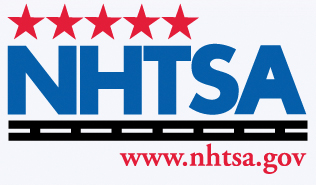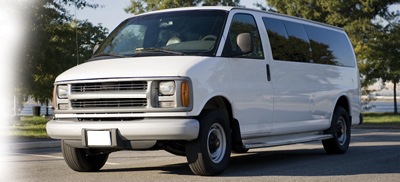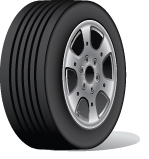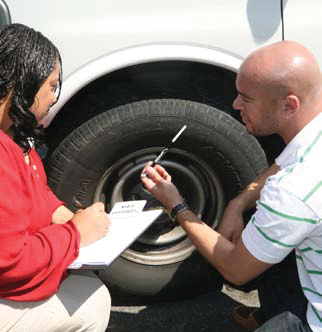

![]()
![]()
TIPS FOR SAFE TRAVEL IN 15 PASSENGER VANS

WASHINGTON, DC – The National Highway Traffic Safety Administration (NHTSA) is urging colleges, church groups, and other users of 15 passenger vans to take specific steps to keep drivers and passengers safe — including buckling up every trip, every time.
Recognizing that 15 passenger vans are particularly sensitive to loading, the National Highway Traffic Safety Administration warns users never to overload these vehicles under any circumstances. NHTSA research shows overloading 15 passenger vans both increases rollover risk and makes the vehicle more unstable in any handling maneuvers.
Tire pressure can vary on front and back tires that are used for 15 passenger vans. This is why the agency urges vehicle users to make certain the vans have appropriately sized and load rated tires that are properly inflated before every trip. Taking into account the fact that tires degrade over time, NHTSA recommends that spare tires not be used as replacements for worn tires. In fact, many tire manufacturers recommend that tires older than 10 years not be used at all.
Following are safety tips for anyone planning a trip in a 15 passenger van:
Passenger Van Safety
Passenger vans handle very differently from smaller passenger vehicles because they are typically longer, higher, and wider. They require additional reliance on the side mirrors for changing lanes, more space, additional braking distances, and have a higher risk of crashes and rollovers if not properly driven and maintained. These vans are often used by various groups and organizations.
57 percent of 15 passenger vans have, at least, one significantly under inflated tire.
Higher Rate of Rollover
NHTSA research shows there’s a greater risk of rollover due to:
NHTSA’S TOP SAFETY RECOMMENDATIONS FOR 15 PASSENGER VAN USE TIRE PRESSURE TIRE PRESSURE Inspect the tires and check tire pressure before each use. A van’s tires need to be properly inflated and the tread should not be worn down. Excessively worn or improperly inflated tires can lead to a loss of vehicle control and possibly a rollover. Pressure for front and back tires may be different, and pressure is likely higher than that required for car tires. A placard on the driver’s side B-pillar or the owner’s manual lists manufacturer recommended tire size and pressure. |
 |

SPARES
Avoid using old spares when replacing worn tires since all tires, even unused tires, weaken with age. Used 15 passenger vans may come with new looking spare tires that are many years old and could be dangerous.
 |
DRIVER 15 passenger vans should only be operated by trained, experienced drivers who operate these vehicles on a regular basis. The driver needs to possess a valid driver’s license for state of residence (a commercial driver’s license is preferred). 15 passenger van drivers need additional training since these vehicles handle differently than passenger cars, especially when fully loaded. |
ATTENTION
Driver should be well rested and attentive to driving at all times. Cell phone use by the driver while the van is in motion should be prohibited. Driver should also limit conversation with other passengers, and drive time should be limited to eight hours per 24 hour period.
SIZE
A 15 passenger van is substantially longer and wider than a car, and thus requires more space to maneuver. It also requires additional reliance on the side view mirrors for changing lanes.
SPEED
Drive at a safe speed based on driving conditions. Driver should never exceed the posted speed limit. Always slow down if the roads are wet or icy because 15 passenger vans do not respond well to abrupt steering maneuvers and require additional braking time.

OCCUPANCY
Never allow more than 15 people to ride in a 15 passenger van. When the van is not full, passengers should sit in seats that are in front of the rear axle.
CARGO
Cargo should be placed forward of the rear axle and placing any loads on the roof should be avoided. Do not tow anything behind the van. See the vehicle owner’s manual for maximum weight of passengers and cargo and avoid overloading the van.
SEAT BELTS
All occupants need to wear seat belts at all times. Inspect seat belts regularly and replace any missing, broken or damaged belts and/or buckles. An unrestrained 15 passenger van occupant involved in a single vehicle crash is approximately three times as likely to be killed as a restrained occupant.

Safety Technology
Understanding vehicle safety features is critical when purchasing a car. For over 30 years, the National Highway Traffic Safety Administration (NHTSA) has driven high tech safety innovations and helped consumers buy safer cars through its 5-Star Safety Ratings System. Starting with 2011 models, enhanced technology is paving the way for more rigorous testing, and ultimately safer cars.
Driving the Development of Safer Cars
Auto safety has evolved from basic seatbelts and lighting to high tech safety features that can help drivers avoid accidents altogether. Thanks to continuing innovation, today's vehicles are the safest in history and have contributed to year over year decreases in crash related fatalities and injuries nationwide.
